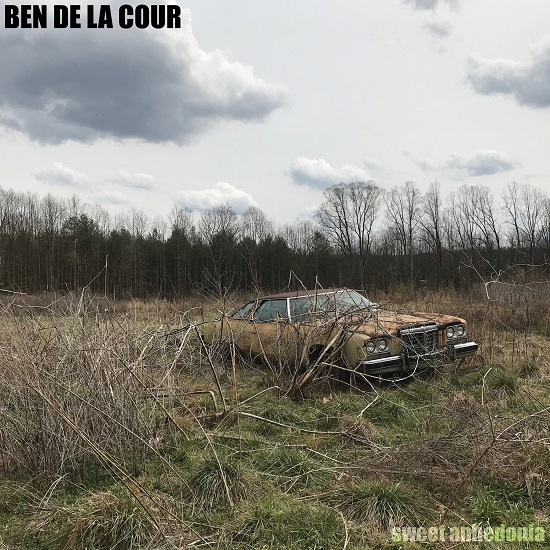
Usually the most difficult thing about reviewing music is working out where to start. Ben de la Cour solves that problem by giving the title song of his new album an enigmatic and intriguing title of ‘Sweet Anhedonia’. I had to look it up, and, logically enough, it comes from the same Ancient Greek root as hedonism and it means the inability to feel pleasure; it’s usually associated with illnesses such as depression. Maybe it’s just a coincidence, but there may be a reference to the 1996 Catatonia single, ‘Sweet Catatonia’. The title song, ‘Sweet Anhedonia’, is a melancholy exploration of this condition with a haunting triple time arrangement enhanced by delicate backing vocals and pedal steel.
There’s a lot more to Ben de la Cour than melancholy. There’s some wordplay in the song titles ‘Appalachian Book of the Dead’ and ‘Suicide of Town’, there are a couple of co-writes with very interesting songwriters, some great stories and some interesting arrangements. One of the co-writes, ‘Numbers Game’, was written with the gifted Canadian singer-songwriter Lynne Hanson and deals with the loading of life’s dice in favour of the privileged, set against a backdrop of finger-picked acoustic guitars, fiddle, pedal steel and Laurel Canyon harmonies.
Don’t run away with the idea that ‘Sweet Anhedonia’ is just a bunch of sad songs. The riff-driven ‘Suicide of Town’ is pure FM drivetime with a vocal that hints at Tom Petty and Rob Thomas and guitars playing off against each other, while ‘Shine on the Highway’ combines two electric guitars with fiddle and trumpet to create a song that would feel at home on a Greg Dulli solo album. And talking of influences, ‘American Mind’ hints at Jackson Browne’s apocalyptic feel from ‘Before the Deluge’, with the addition of Vietnam references and martial drumbeat (which is also a common theme throughout the album) for emphasis.
‘Palookaville’ features a series of characters that would fit in perfectly on any of the first three Springsteen album and uses Buddy Holly as an example of an artist whose legacy is untainted because he wasn’t around long enough to go downhill and either hit the skids or end up playing residencies in Vegas.
‘Sweet Anhedonia’ is a lyrically thought-provoking set of songs set against diverse musical backgrounds and textures, incorporating influences from Americana, folk, rock, pop and a whole lot more, skilfully blended to create a work that is entirely Ben de la Cour.
‘Sweet Anhedonia’ is released in the UK on Jullian Records (JR32CD/LP) on Friday October 13th.
Here’s the video for ‘Shine on the Highway’:
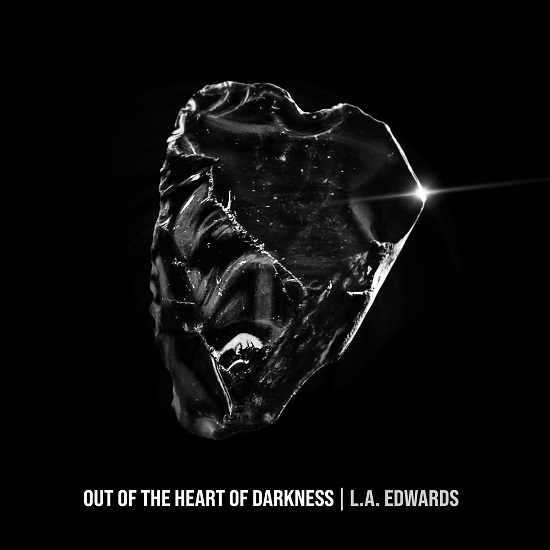
Imagine driving along the freeway in the early eighties. The sun’s shining, the roof’s down and the radio’s tuned to the local FM station. You could be listening to any song from the L.A. (Luke Andrew) Edwards album ‘Out of the Heart of Darkness’. Unfortunately the press pack didn’t come with a time machine, so it was a Skoda on the A12 but at least the sun co-operated. The album’s packed with nine classic FM style rock songs influenced by the bands of the late seventies and the early eighties mixed with Luke Edwards’ acoustic folk roots to create a widescreen sound that’s difficult to resist.
The album starts with a haunting spoken intro from a child in some sort of distress before launching into ‘Little Boy Blue’ which opens with the album’s trademark jangling guitars overlaid with a synth line. The chiming guitars, harking back to Tom Petty, The Byrds and even the Mersey Sound are a constant throughout the album and L.A.’s slightly nasal intonation emphasises the Tom Petty connection (his first solo album was produced by former Heartbreaker Ron Blair) and there are hints of other influences as well. Creedence Clearwater Revival and the Laurel Canyon groups; Neil Young, Eagles and so on, but there are a few surprises as well.
Most of the musical stylings are standard rock band arrangements (drums, bass, guitars and keys) but there are a few surprises as well. ‘Already Gone’ (not an Eagles cover) begins with a swirling Wurlitzer prelude before the sticks click and the band blasts into the song. There’s a good use of dynamics throughout the album as songs build up gradually and there are plenty of breakdowns to vary the tempo and power. ‘Stick to You’ is another interesting blend of styles, combining L.A.’s earlier folk roots with rock instrumentation and some tribal floor toms to create something that edges into Waterboys territory.
There’s plenty of novelty in the combinations of styles across the album, but there are a few of the old tricks as well including the squalling feedback intro on ‘Now You Know’ and the twin lead guitars opening ‘Time to Go’. There’s even the unapologetic drug references of ‘Hi Rite Now’; it’s got all of the ingredients for a classic rock album.
‘Out of the Heart of Darkness’ is released in the UK on Friday June 2nd and the band will be touring the UK and Europe in early July.
Here’s the video for ‘Already Gone’:
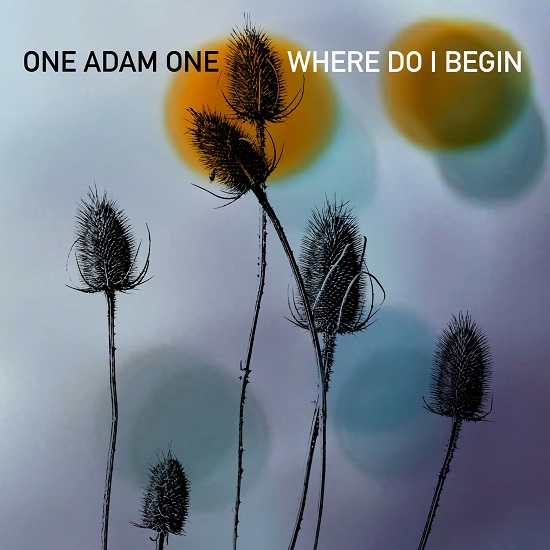
‘Where Do I Begin’ is a perfect example of the way digitisation and the internet has changed the music business. The conventional business wouldn’t know how to deal with it; five songs (OK, six if you count the no-swearing version of ‘Living Between the Lines’) is too much for an EP and not enough for an album (unless they’re eight-minute prog rock epics). Cutting out the major label bureaucracy means that if you have five great songs that hang together well, you can get it to the market fairly easily and call it a mini album. That’s exactly what Adam Reichmann and Todd Schnitzer have done with their debut as One Adam One.
The album’s almost a two-man show with Reichmann and Schnitzer singing and playing everything apart from some background vocals from Stephanie Stewart and a bit of baritone guitar from John Horton. Two things defining the album are the layers of instruments and vocals created by producer Todd Schnitzer and the fragile, vulnerable vocal of Adam Reichmann, at times on the edge of cracking completely, combining to create a beautiful melancholy feel across the five songs using all of the country/Americana palette (including pedal steel) and even a bit of harpsichord. The layering of tracks and use of reverb create an other-worldly feel that emphasises the melancholy style of the slow tempos and the vulnerability of the lead vocals.
Apart from the uptempo ‘Cold Murmurs’ with its driving tempo, lovely harmonies and maybe a hint of Tom Petty’s ‘Running Down a Dream’. It’s a song of renewal and optimism that offers a vivid contrast to the more downbeat songs that dominate the album. The opening song, the appropriately titled ‘Where Do I Begin’, builds from a gentle strummed acoustic intro to a full band arrangement with synths as the lyrics tell a story of hopelessness and helplessness after a broken relationship, while the closer, ‘Platte River’, is a slow, organ-driven, piece of nostalgia for a lost place, time and relationship.
‘Hollywood Ending’ has an arrangement that builds to a big finish as the lyrics explore the gulf between real life and the media presentation of life; it’s powerful stuff. Finally, ‘Living Between the Lines’ (my personal favourite) has an ominous reverbed guitar intro before Adam Reichmann’s vocal comes in the higher end of his range, almost cracking at times. The song tells the story of the unsung and unnoticed who do all of the things that we take for granted. The chorus is absolutely gorgeous.
‘Where Do I Begin’ is five great songs, arranged cleverly to enhance the melancholy content of the songs and, ultimately, the upbeat sense of rebirth in ‘Cold Murmurs’. It may only be five songs, but it creates a sense of sadness, anger and nostalgia before taking a more positive turn. The album is a lovely snapshot of the genesis of One Adam One; I’m hoping there’s a lot more to come.
‘Where Do I Begin’ is released on Die Trying Records in the UK on Friday March 31st.
Don’t just take my word for it, here’s the video for ‘Living Between the Lines’:
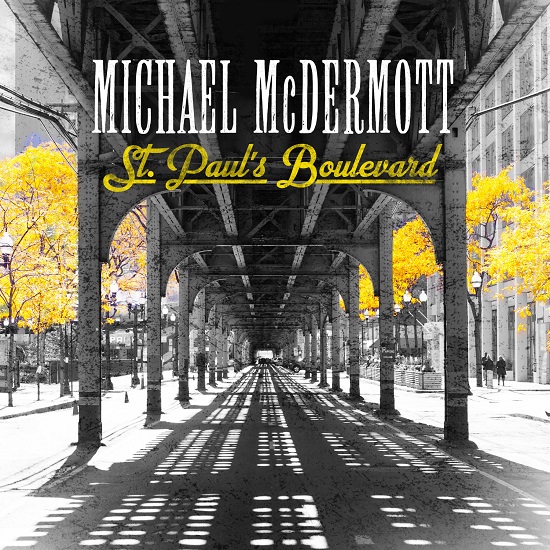
Michael McDermott isn’t making life easy – every year he releases an album (sometimes even two) that grabs your attention immediately with quality of the songwriting, the quality of the playing and arrangements, and the sheer variety of influences from the classic American pop/rock songbook. The difficulty lies in trying to think of something new to say about this steady sequence of excellence. There are some easy comparisons to make, but when all of those have already been made, it’s a challenge to know where to go next. I guess it’s safe to say that ‘St Paul’s Boulevard’ is a continuation of the winning sequence; it’s a classic album that would be huge if we still had a significant market for albums.
There’s a narrative running through Michael’s work since The Westies ‘Six on the Out’ of degradation, recovery and redemption. ‘St Paul’s Boulevard’ feels like a postscript to that narrative, looking back to the lowest of times with clear-eyed detachment and looking forward to the future with technicolour optimism. As you would expect from a Michael McDermott album, ‘St Paul’s Boulevard’ is packed with historical, geographical, mythological, literary, biblical and popular culture references, particularly ‘Marlowe’ which is a nod in the direction of Deacon Blue’s ‘Real Gone Kid’ and a tribute to Raymond Chandler’s sleuth Philip Marlowe.
The arrangement of title song is a slow builder; the ambient intro with slide and piano gradually fills out into a full band sound as the various characters in the story make their brief appearance. The Boulevard is that place we have in our history that’s full of possibility for triumph or tragedy; the place where we met characters that would have positive and negative impacts on our lives. There are a few references to heroes on the album and the most telling is probably in this song: “None of the heroes around here have capes, they’re just talking in taverns and on fire escapes”.
Michael McDermott isn’t afraid of throwing in musical or lyrical references; ‘Where the Light Gets In” has a hint of Coldplay’s ‘Higher Power” and the obvious Leonard Cohen reference, while there’s plenty of chiming guitar in Byrds/Tom Petty/Flaming Groovies style. While we’re on the subject of guitars, a true master of the fretted stringed instrument plays on the album and any project featuring Will Kimbrough is going to be good; he plays guitar, mandolin and banjo across the album.
‘St Paul’s Boulevard’ is another powerful Michael McDermott album that blends musical references from folk, soul, country, rock and other areas to produce an album that looks back to difficult times but also looks forward with optimism (“Peace, lave and brilliant colours to you all”). It’s a celebration of this moment and the moments to come.
‘St Paul’s Boulevard’ is out now on Pauper Sky Records (PSR010).
Here’s the video for the album’s final track, ‘Paris’:
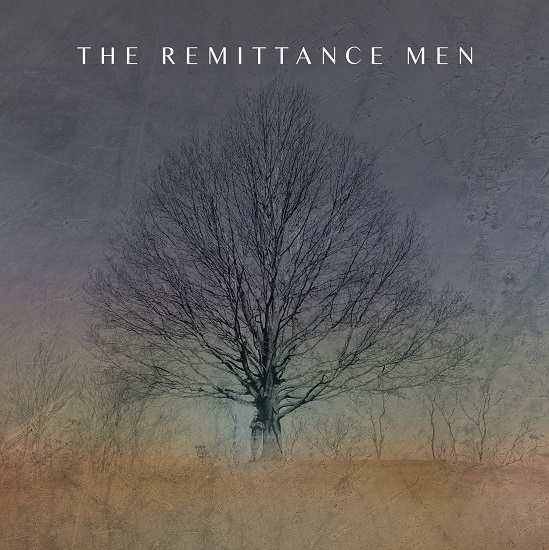
“Scoundrels, Dreamers and Second Sons” is the debut album from The Remittance Men, a bunch of very gifted musicians from Boston, Massachusetts playing the songs of singer songwriter Tom Robertson (plus a couple of well-chosen covers). The band formed about two years ago as the pandemic broke and put together this collection of songs over that period. It’s difficult to pin down a specific genre; the song arrangements combine elements of the traditional string band with fiddle, mandolin, upright bass and acoustic guitar, keyboards, pedal steel and electric guitars from the country tradition, trumpets evoking Central America and even a horn section on “Lila Page 8”. It’s a wide palette and The Remittance Men fully explore its texture and colours. The varied elements are pulled together by the quality of Tom’s songs and his gravelly vocal delivery that never seems forced.
The songs are full of little vignettes; short descriptions of people and places fitting together to form the narrative framework of songs such “Sweet Thunder” following the route back home across America and “Lonely and Silent”, tracing the broken lives of people left behind as small businesses in rural America fell to the power of the multinationals; it’s not pretty, but it’s authentic. There are songs that feel deeply personal, without being particularly explicit, including the poignant opener, “1973 (Life on the High Seas)” and the historical “A Room in Birmingham England, 1919”.
The two songs that particularly grabbed my attention are probably the furthest from the traditional Americana canon, “Hacienda Santa Rosa” and “Lila Page 8”. “Hacienda…” uses Mexican rhythms and the inevitable trumpet to create a setting that works for the song’s lyrics. Moving in a completely different direction, “Lila Page 8” starts with a saxophone and trumpet intro and builds steadily to a full-on E Street Band/Asbury Jukes rock and soul arrangement with guitar solos flashing across the strident horns and big backing vocals. It’s a huge arrangement, and the heartfelt delivery suggests that this is another deeply personal song. Of the two covers, Tim Gearan’s delicate love song in triple time, “Nobody” follows “Lila…” contrasting with the massive arrangement and creates a low-key finish to the album. And the other cover is Tom Petty’s “Down South”, which fits in perfectly with pan-American feel of the album.
This is a fascinating debut from a writer with a gift for subtly combining a kaleidoscope of lyrical impressions against a backdrop of understated instrumental performances to create songs that just won’t quit.
“Scoundrels, Dreamers and Second Sons” is released on Friday March 25th on Blonde on the Tracks Records.
Here’s the video of “A Room in Birmingham England, 1919”:
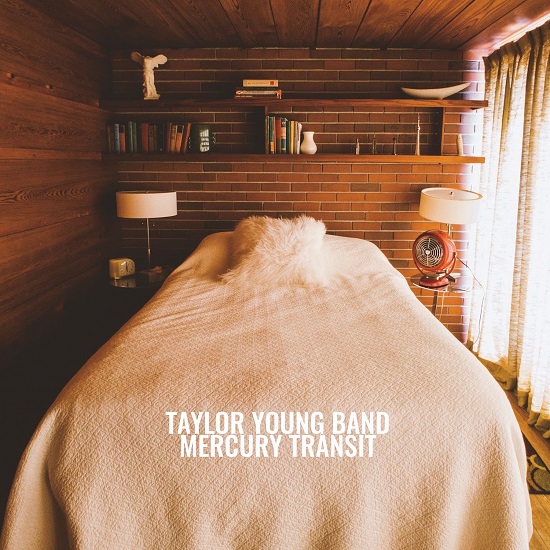
There’s no denying the musical lineage of “Mercury Transit”. The melodic style and chiming guitars go all the way back to the Merseybeat scene of the early sixties and the songs have more than their fair share of the sus4 and sus2 chords that characterise that particular era. Taylor Young certainly isn’t the first and probably won’t be the last to be influenced by this purple patch in British pop history; the thread runs through the work of The Byrds, Alex Chilton, Flaming Groovies, Tom Petty, The Pretenders, The La’s and Teenage Fanclub and probably many more. Taylor’s in pretty good company there.
It looks like a step change from Taylor Young’s previous incarnations as drummer in the psychedelic band Hi-Fi Drowning and singer in folk-rock duo, The O’s but, in reality, it’s more of a combination of the two sets of influences with the addition of great harmonies and melodic bass lines to create a new style of twenty-first century power pop. You won’t find any penetrating political insights here, but you will find ten uplifting country-inflected pop songs built around traditional pop themes – love, loss, and drinking, of course.
The album starts with a statement of intent. “Get Around” opens with a La’s-style jangly guitar intro and packs a West Coast punch that doesn’t overstay its welcome at two minutes twenty. A bit like Thin Lizzy’s “Don’t Believe a Word”; if you can pack everything into that time, why add any unnecessary embellishments. The following song, “Make You Wanna Stay” goes right back to the Merseybeat roots of jangle with a melodic bass line, nods to the Fab Four and a slightly hurried vocal delivery that’s typical of sixties UK pop.
Most songs on the album seem to be a hat-tip in the direction of a follower of the jangle-pop style. The optimistic “Five Cents” has a strong feel of James Honeyman Scott-era Pretenders, while “Rattled”, after a synth intro, is pure Tom Petty and the Heartbreakers. The album’s closing song “Drinkin’” bucks the trend slightly by sticking to a more country style while Taylor’s voice is pitched slightly lower as he tells the familiar tale of the drinker blaming everyone else for his woes while slipping in a reference to Garth Brooks as well.
This album has unashamedly retro influences while sounding very contemporary. If you’re going to wear your influences on your sleeve, the ones mentioned above are a pretty good set. If this album doesn’t make you feel good, I’ll eat my chapeau.
“Mercury Transit” is out now on Hand Drawn Records.
Here’s the video for “Rattled”:
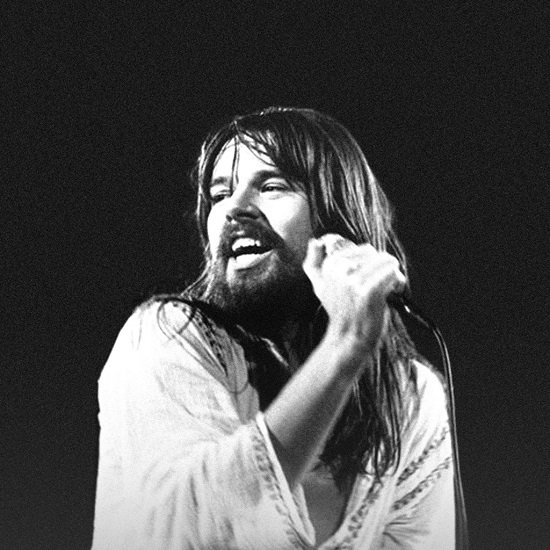
Here’s a strange coincidence that brings a bit of musical history solidly back into the present. I had almost finished this piece and was in the process of editing, stepping away from and tweaking when I felt the need to go and photograph some live musicians again. On most Sundays during the summer months, you can catch some solo performers and duos at Eccleston Yards near Victoria Station in London. The gigs are organised by Talentbanq, a company that promotes unsigned musicians, mainly in small venues and you can usually find its hands-on CEO Ray Jones there as compere and sound engineer. The first performer on stage was Erin Bowman, from New Jersey via California, playing a mixture of classic rock interpretations and original material. I was hooked from the start by her laid-back acoustic version of Tom Petty’s “American Girl”, but the last song in the set was the one that did it. In London, in 2021, Erin was doing her version of Bob Seger’s “Against the Wind”, originally released in 1980. Never underestimate the staying power of a great song.
If you’ve been seriously into music for over fifty years, then you’ve had an artist (or a few) that got away. The ones you were convinced would be massive but didn’t make it at all, or only in certain territories. One of mine was Bob Seger, with or without The Silver Bullet Band. I knew he deserved be a UK Top 20 artist, but it took about twenty years to prove me right (sort of).
It’s been a long journey, but where did it start? Nottingham’s commercial station Radio Trent in 1974, I guess. I heard “Get Out of Denver” blasting out of a tiny radio speaker and I was hooked. No doubts, no second thoughts, this was the mutt’s. Was it a Chuck Berry rehash? Of course it was, but Chuck could never have written those lyrics and his laconic drawl wouldn’t have allowed him to fire and spit them out the way Bob Seger did. This was “Tulane” on steroids and I was hooked, although it would take a couple of years before I was finally reeled in.
Bob Seger spent years grinding round the Midwestern circuit building up a massive and loyal live following before first troubling the US singles charts in 1967 and 1968 respectively with “Heavy Music” and “Ramblin’ Gamblin’ Man” which both went on to become huge live favourites. He was a classis seventies example of building up a live fanbase to help (eventually) sell records. During the period between ‘68 and ’75, his band went through personnel and name changes and moved from Capitol to Reprise and back again. Reprise had tried to break him through into the mainstream, even trying to break the UK, but they were only reaching musicians and the committed (“Get Out of Denver” was covered by Eddie and the Hot Rods and Dave Edmunds and “Rosalie” was covered by Thin Lizzy). So back to Capitol again.
What happened next was really interesting. The first Capitol album, “Beautiful Loser” was the blueprint for what was to come over the next ten years. It was a combination of up-tempo rockers (“Katmandu”) and slower, more nostalgic pieces (“Fine Memory” and “Momma”), the well-chosen cover (“Nutbush City Limits”) and the classic wistful mid-tempo pieces (“Beautiful Loser” and “Jody Girl”). Its peak chart position in the US was 131, but it went on to hit double platinum certification. It wasn’t perfect, but everyone involved knew that this was the template; more of the same would do very well indeed, but there was a way of building up a head of steam before the next studio album. The mid-70s was the era of the double live album; if you had a band that could reliably turn it on live and you put them in front of a friendly crowd you had an instant hit, so that’s what Capitol did.
“Live Bullet” was the clincher; a classic example of a live band at their peak. You got Bob Seger originals, including the classic-to-be “Turn the Page” (later covered by Metallica) and covers of “Nutbush City Limits” and “Let It Rock”. It went quintuple platinum in the US and now no-one was looking back. In the space of a year Bob Seger had arrived, at least in the US. It was always a mystery to me that no-one else in the UK seemed to get this but, with hindsight, it was just too American for the time. In 1975 Bob Seger stood a chance of being bracketed with the better bands breaking out from the pub rock scene, but was doomed in the UK after the insular and inward-looking punk explosion. It wasn’t stopping me; I grew up in a town where any sort of escape, to London or Detroit, was a good thing. And if I’m honest, the inner music snob in me likes to support an artist/band that no-one else has heard of.
As far as the North American continent (and later, Australia) were concerned, Bob Seger had made it. In the US alone, he sold over 30 million albums between 1975 and 1991, and that’s people who went to their local record shop and parted with cash for vinyl, cassette, eight track (remember that) and, towards the end, CD. The stars had aligned; the formula for the albums had been established with “Beautiful Loser”, the songwriting was perfectly honed, the production was superb (and don’t underestimate the importance of the backing vocalists from “Night Moves” onwards), Capitol was 100% behind the artist and The Silver Bullet Band was the perfect vehicle to go out and sell the songs to a live audience. Between 1975 and the peak, when “Against the Wind” hit Number One in the US album charts in 1980, Bob Seger could do no wrong in his home territory, Australia and big chunks of Europe, so why not the UK? Two obvious reasons.
The first one is about economics. Despite a reasonable amount of radio play, only the albums “Stranger in Town” and “Against the Wind” made any impact on the album charts and the singles did even worse. It was the wrong kind of music for the UK at that time despite being huge across the pond. It didn’t really make any economic sense for Capitol/EMI to invest huge amounts in touring the UK if it didn’t significantly add to record sales, and they were probably right. The Silver Bullet Band only played five gigs in Britain and I was at two of those; Glasgow Apollo (14/10/77) and Wembley Arena (21/11/1980). I’m slightly biased, but both were stunning gigs that were well-attended by wildly enthusiastic audiences and they were his first and last UK gigs. Unfortunately, you couldn’t break the UK market with five gigs. If you were counting the beans at Capitol/EMI, why would you invest any more in a territory like the UK when you could tour arenas in the USA and Canada promoting new albums and selling shedloads of merchandise. I understand that completely.
The second point is a bit more controversial, and more stalwart Bob Seger fans might want to stop reading now. I’m still a huge fan, but I couldn’t honestly say that there was one album that I wouldn’t want to skip an odd track on (with two exceptions, coming later). From 1975 onwards, Capitol/EMI were pitching Bob Seger at the traditional album market and they didn’t seem to see that the material wasn’t always even. “Night Moves”, “Stranger in Town” and “Against the Wind” had more than their fair share of classic songs, but they weren’t consistent or consistently excellent. You want reasons for that? Pressure to write brilliant new songs for albums every eighteen months while touring constantly, using the Silver Bullet Band for part of each album and The Muscle Shoals Rhythm Section for the other part, or maybe just burnout. The albums had to keep appearing regularly to satisfy the public, whether they were perfect or not. After “Against the Wind”, sales started to slow and gaps between albums increased as Seger’s family life became more important. And that should have meant the last chance for UK success, but you never know, do you?
In the summer of 1996, I was in the Pub on the Pond in Swansea having lunch with my mate Bekky when I heard a familiar voice from the CD jukebox (remember them?). It was Bob Seger and I had to go over and check it out, because it wasn’t a song I’d heard him play. It was a storming cover of the Chuck Berry classic “C’est la Vie”/”You Never Can Tell” and the album was “Greatest Hits”, released in the UK in 1994 which sort of proved my theory that Bob Seger had a huge number of classic songs but they weren’t all on the same album. It reached Number 6 in the UK and also spawned the first UK Top 40 single with “We’ve Got Tonite”. It probably helped that the songs were all FM radio-friendly and continued to be played on pockets of UK radio long after their initial release. There was a certain irony that Brits nostalgic for the 70s were buying into an album that was packed with nostalgia for 1950s/60s America. It’s a near-perfect album and the UK marketing worked like a dream.
There was another Seger album I would happily listen to all the way through, and it was intended to be the swansong. “Ride Out” was released in 2014 and it would have been a fitting famous final scene; it’s a classic album that I would recommend to anyone. Only it wasn’t the final album; as a response to the death of his long-time friend from Detroit, Glenn Frey in 2016, he released one final album, “I Knew You When” as a tribute, in 2017. That was the second encore and Bob Seger had finally left the building.
As a long-time fan, it was a validation that he finally achieved success in the UK even if it was a little late. If the run of albums starting with “Night Moves” had started a year earlier or five years later, things might have been very different, but it won’t keep him awake at night – he sold over 75 million records worldwide, wrote songs that were covered by almost everyone (there are over sixty covers of “We’ve Got Tonite”) and finished his career on his own terms. He wrote classic songs that we could all relate to and, if “Against the Wind” isn’t played at my funeral, will you all please deal with the people responsible. If you already know his work, you’ll probably understand why I’ve written this; if not, you could do a lot worse than check him out anyway. Rock and roll never forgets.

We first reviewed one of Anna Laube’s albums in 2015. She’s grown since then; since her 2016 album “Tree”, she’s now Anna Elizabeth Laube and her latest album, “Annamania” is a compilation of songs from her four previous albums dating back to “Outta My Head” in 2006. The song choice is heavily skewed towards the newer material from “Anna Laube” (2015) and “Tree” (2016) and also includes three songs previously either not released or given a limited release, including Anna’s reimagining of Tom Petty’s “Time to Move On”. Apart from this, it’s originals all the way.
The Tom Petty cover is a great example of making a song your own. Tom Petty’s original sounds like, well, Tom Petty, but Anna gives it a different spin, creating a piano arrangement with a Rickie Lee Jones twist and adding French horn tracks for an even more distinctive feel. It’s perfect.
The album has the variety and pacing that you would find on any of the previous four albums as Anna demonstrates her instrumental versatility and ability to move effortlessly from a pure, unadorned vocal (as on the album’s opener “Sweet Boy from Minnesota”) to the rasping, lo-fi twelve-bar blues of “If You Build It”.
“Annamania” is a perfect showcase for Anna’s work. It demonstrates her multi-instrumentalism, her perfect voice and her ability to create memorable songs across a wide range of subjects, from the innocent love song that opens the album to the environmental message of its closer, “Tree”. Her geographical and musical wanderings have all contributed to the eclecticism of this and Anna’s four previous albums. There are hints of Rickie Lee Jones in the Tom Petty reworking and also in “Oh My! (Oh Me Oh Me Oh My)” a mid-tempo shuffle that evokes Rickie Lee’s “Danny’s All-Star Joint” from the eponymous first album. The achingly beautiful “Please Let it Rain in California Tonight” even has a nod in the direction of Eric Clapton’s “Tears in Heaven” in the chords leading into the verse. There’s a lot to love about this album.
If you haven’t listened to any of Anna’s previous albums, “Annamania” is a pretty good place to start. The songs are strong and the album clearly shows Anna’s variety of vocal stylings, multi-instrumental skills and studio expertise. Anna Elizabeth Laube is a unique talent and “Annamania” is a perfect introduction.
“Annamania” is released to download and stream on Friday January 22nd.
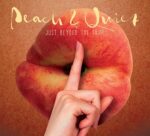 It’s drizzling, freezing and absolutely miserable in the UK at the moment, so that would be the perfect time to listen to an album straight out of 1970s Laurel Canyon via 2020s British Columbia. There are more influences on the album than the Jackson Browne/Eagles/Linda Ronstadt coterie but the album still glows with sunshine of The Golden State, even though its creators Heather Read and Jonny Miller have fairly nebulous Californian connections but, hey, the first two Eagles albums were produced by Glyn Johns at Olympic Studios in London, while Peach & Quiet’s “Just Beyond the Shine” was put together with the help of producer and multi-instrumentalist Steve Dawson in Nashville, Toronto, Vancouver and Victoria. All of the songs are written by Heather, Jonny or both apart from the album’s closer, “Seven Daffodils”, written by Lee Hays and Fran Moseley.
It’s drizzling, freezing and absolutely miserable in the UK at the moment, so that would be the perfect time to listen to an album straight out of 1970s Laurel Canyon via 2020s British Columbia. There are more influences on the album than the Jackson Browne/Eagles/Linda Ronstadt coterie but the album still glows with sunshine of The Golden State, even though its creators Heather Read and Jonny Miller have fairly nebulous Californian connections but, hey, the first two Eagles albums were produced by Glyn Johns at Olympic Studios in London, while Peach & Quiet’s “Just Beyond the Shine” was put together with the help of producer and multi-instrumentalist Steve Dawson in Nashville, Toronto, Vancouver and Victoria. All of the songs are written by Heather, Jonny or both apart from the album’s closer, “Seven Daffodils”, written by Lee Hays and Fran Moseley.
The sun breaks through from the opening notes of the Byrds/Tom Petty-inflected opener, “Empty to Fill” and its poetic exploration of the contradictions and complexity of human beings. From there it’s almost constant Oakley and Ray-Ban stuff, with the exception of the slightly menacing Southern-influenced “Shoreline After A Storm” likening a bad relationship to a storm – they can both inflict terrible damage and leave a messy aftermath. There’s a little hint of “I Put A Spell on You” in there as well.
The songwriting is superb throughout, from the fairly straightforward love song “There’s A Very Good Chance” with its lovely Everlys harmonies to the more complex “Flowers”, which is based on the children’s book “Mr Cat and the Little Girl” which deals with love and loss which has a folky Byrds styling with a relatively complex arrangement that even features a bit of glockenspiel, courtesy of Steve Dawson.
There are themes running though the album; lyrically it’s all about love, whether it’s love for a partner who’s on stage every night (“Lucky in Love”) or for a place (“California Way”). The song arrangements are in the Eagles/Linda Ronstadt mode with layers of electric and acoustic guitars and some absolutely gorgeous harmonies, either as duets or as multi-tracked layers. There’s absolutely nothing out of place on this album.
And, as I finish this review, there’s no rain, and the sun is shining; that was pretty impressive work, guys. This album’s combination of superbly-crafted songs and subtle Laurel Canyon-era arrangements is the perfect antidote to winter on either side of the Atlantic.
“Just Beyond the Shine” is released on January 15th 2012 on Peach & Quiet Music (P&QCD001).
Here’s the video for “Empty to Fill”:
 This is the final album review of the strangest year I’ve had in a very, very long time. It’s quite unusual to release albums of original material in December; it’s normally a time for retrospectives, compilations and TV personalities singing Christmas songs. This year, however, all bets are off as the virus has closed so many doors while opening a few new ones. Musicians have been adapting to a rapidly-changing environment throughout this century, so what’s the big deal about a pandemic? Home studios have been with us for a long time and it’s routine now to share huge audio files online; you can make an album with dozens of musicians without ever meeting them.
This is the final album review of the strangest year I’ve had in a very, very long time. It’s quite unusual to release albums of original material in December; it’s normally a time for retrospectives, compilations and TV personalities singing Christmas songs. This year, however, all bets are off as the virus has closed so many doors while opening a few new ones. Musicians have been adapting to a rapidly-changing environment throughout this century, so what’s the big deal about a pandemic? Home studios have been with us for a long time and it’s routine now to share huge audio files online; you can make an album with dozens of musicians without ever meeting them.
The album “Mayone”, by songwriter and multi-instrumentalist Steve Mayone, has a couple of reference points. The uncertainty generated by COVID 19 gave the Steve the impetus to get this album together, and the first Paul McCartney solo album “McCartney” (fifty years old this year) gave him the inspiration. The parallels between the two aren’t just around the experience of working alone in the studio alone as therapy; Steve has echoed the ebb and flow of Paul McCartney’s album, and some of the themes as well (more about that later).
The first listen to this album left two lasting impressions; that it was a guitar player’s album and that it had a very seventies feel. Before reading the press release, I felt that the album had the feel of a solo Beatles project (right) and that the solo Beatle was George Harrison (wrong). It’s definitely a guitar player’s album, though; there are multiple layers of acoustic and electric guitars throughout the album, with the additional spicing of mandolin, banjo, ukulele and lap steel. I’m sure one of Steve’s aims was to make people revisit “McCartney”; it worked in my case and I’m recommending it to you as well.
“Mayone” has thirteen tracks (as does “McCartney”) and mixes up instrumental soundscapes with some beautifully-crafted songs. The instrumentals are perfect little vignettes scattered across the album, starting with the finger-picked acoustic, “The Sweet Suzanne” referencing McCartney’s “The Lovely Linda” even down to the alliteration in the title; Steve Mayone is paying serious attention to detail here.
There’s a huge variety to the songs here, from the no-prisoners-taken rock of “Sweet Little Anchor”, hinting at Bob Seger and Tom Petty to the melancholy “Airport Goodbyes” and the archetypical Christmas song (with an ironic drunken stupor twist), “Happy Alcoholidays”. These are all great songs but the perfect McCartney match is still to come. “Stuff” is a takedown of consumerism on a personal and global level that moves McCartney’s “Junk” on by fifty years, but Steve takes it a stage further. The McCartney “Junk” appears in a vocal version on track six and as “Singalong Junk” (an instrumental) on track eleven; guess the track sequencing of the “Stuff” vocal and instrumental on Steve’s album?
Steve Mayone has created an album of material that’s totally original, while cleverly referencing and emulating McCartney’s “McCartney”. “Mayone” is a 2020 classic; let’s hope it lasts as long as “McCartney”.
“Mayone” is released in the UK on Friday December 18th on Mayone Music.


